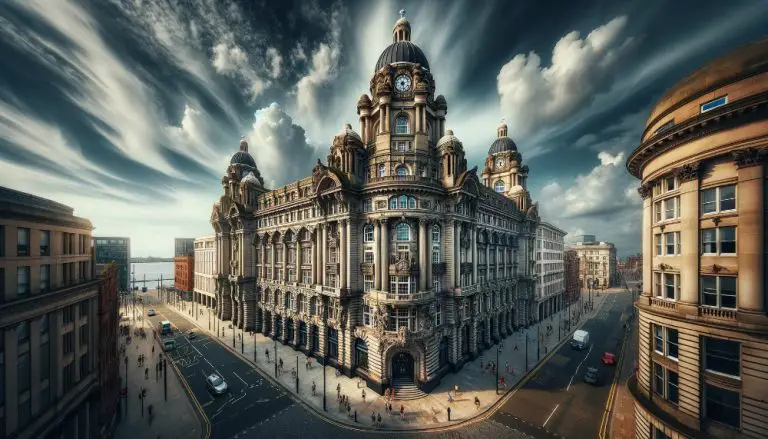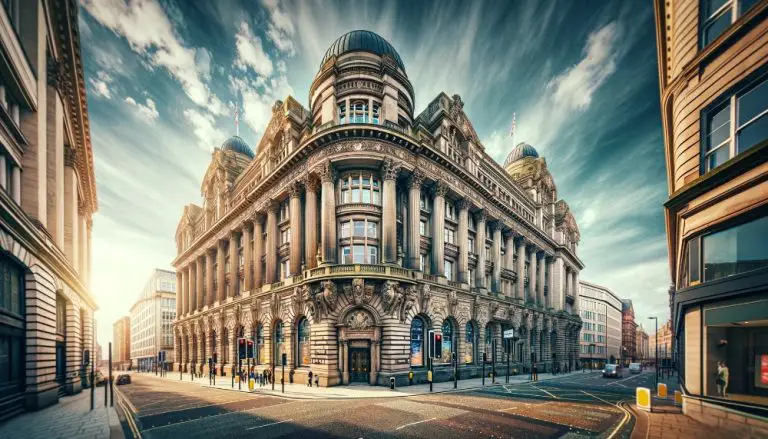Port of Liverpool Building: A Historic Liverpool Dock Building

The Port of Liverpool Building, also known as the Mersey Docks and Harbour Board Building, is a Grade II* listed office building located at the Pier Head in Liverpool, England. Constructed between 1904 and 1907, this magnificent structure stands as a testament to Liverpool’s rich maritime history and architectural grandeur.
As part of Liverpool’s UNESCO-designated World Heritage Maritime Mercantile City, the Port of Liverpool Building is one of the Three Graces that adorn the city’s waterfront, alongside the Royal Liver Building and Cunard Building. Its large dome and ornamental details make it a prominent landmark on the picturesque Mersey River waterfront.
Key Takeaways:
- The Port of Liverpool Building is a Grade II* listed office building located at the Pier Head in Liverpool, England.
- Constructed between 1904 and 1907, it is a prominent landmark on the Mersey River waterfront.
- Part of Liverpool’s UNESCO-designated World Heritage Maritime Mercantile City.
- One of the Three Graces that line the city’s waterfront.
- A symbol of Liverpool’s rich maritime history and architectural grandeur.
History of the Port of Liverpool Building
The Port of Liverpool Building holds a significant place in the maritime history of Liverpool. Built as the headquarters of the Mersey Docks and Harbour Board, the building played a crucial role in the management of Liverpool’s docks and maritime infrastructure. It served as their headquarters for 87 years, until 1994, showcasing its enduring importance to Liverpool’s maritime heritage.
During the Second World War, the Port of Liverpool Building endured the destruction caused by a bomb explosion. However, its resilience prevailed, and it was fully restored after the war, standing tall as a testament to Liverpool’s indomitable spirit and determination.
In 2001, the building was sold to the property developer Downing, who recognized its historical significance and embarked on a major restoration project between 2006 and 2009. This meticulous restoration aimed to preserve the original features and architectural grandeur of the building, ensuring that its heritage would stand the test of time.
Today, the Port of Liverpool Building stands proudly as a Liverpool Waterfront Landmark and holds a place of honor as part of the Liverpool World Heritage Site. Its rich maritime history and architectural elegance make it a Liverpool Heritage Building that attracts visitors from all over the world.
Architectural Design of the Port of Liverpool Building
The Port of Liverpool Building showcases a stunning example of the Edwardian Baroque architectural style. With its grand dome and elaborate design, it stands out as a remarkable Grade II Listed Building in Liverpool. Inspired by a design for Liverpool’s Anglican Cathedral, the building’s focal point is its majestic dome, capturing attention and highlighting its significance as a Liverpool tourist attraction.
The building itself has an approximately rectangular shape, accentuated by canted corners that are topped with stone cupolas. Its exterior is clad in elegant Portland Stone, giving it a timeless and sophisticated appearance. The use of this stone not only adds to the building’s durability but also contributes to its overall aesthetic appeal.
Step inside the Port of Liverpool Building, and you’ll discover an interior adorned with maritime references, ornamental details, and luxurious furnishings. The lavishness is evident in features such as Spanish mahogany, Danzig woodwork, bronze accents, white marble, and grey granite. Every element within the building showcases the meticulous craftsmanship and attention to detail that went into its design.
Key Features of the Port of Liverpool Building
The Port of Liverpool Building is known for its distinctive features and architectural details. Standing at a height of 67 meters, it ranks as the fourteenth tallest building in Liverpool, showcasing its prominence in the cityscape. Although not part of the original design, the building’s central dome is a prominent and eye-catching feature, added at the last minute to enhance its grandeur. The exterior of the building boasts canted corners, hexagonal turrets with small domed cupolas, and exquisite ornamental details inspired by its maritime heritage.
Inside the Port of Liverpool Building, visitors are greeted by an array of stunning architectural elements that continue the nautical theme. The grand granite staircase offers an imposing entrance, while the elevator details showcase the craftsmanship and attention to detail that went into the building’s design and construction. The white marble walls add a touch of elegance and sophistication, evoking a sense of grandeur in every corner. Stained glass windows adorn the building, captivating visitors with their intricate designs and vibrant colors, further enhancing the rich heritage of the building and its connection to Liverpool’s maritime legacy.
To summarize, the key features of the Port of Liverpool Building include:
- Central dome
- Canted corners
- Hexagonal turrets with small domed cupolas
- Ornamental details inspired by maritime heritage
- Grand granite staircase
- Elevator details
- White marble walls
- Stained glass windows
The combination of these features creates a unique and captivating environment that showcases the architectural magnificence and historical significance of the Port of Liverpool Building.
| Feature | Description |
|---|---|
| Central Dome | A prominent feature added to enhance the building’s grandeur. |
| Canted Corners | The building’s exterior is adorned with canted corners, giving it a distinctive appearance. |
| Hexagonal Turrets | The building features hexagonal turrets with small domed cupolas, adding to its architectural charm. |
| Ornamental Details | The exterior showcases ornamental details inspired by the building’s maritime heritage. |
| Grand Granite Staircase | The interior boasts a grand granite staircase that offers an imposing entrance. |
| Elevator Details | The building’s elevators feature intricate details, showcasing the craftsmanship of its design. |
| White Marble Walls | The interior walls are adorned with white marble, adding a touch of elegance and sophistication. |
| Stained Glass Windows | The building’s stained glass windows captivate visitors with their vibrant colors and intricate designs. |
Historical Significance of the Port of Liverpool Building
The Port of Liverpool Building holds significant historical importance as part of Liverpool’s World Heritage Maritime Mercantile City. It symbolizes the city’s prominence as a commercial port during Britain’s global influence.
The building’s association with the Mersey Docks and Harbour Board highlights Liverpool’s maritime history and its role in international trade. The Port of Liverpool Building stands as a testament to the city’s rich heritage and architectural grandeur.
Today, the Port of Liverpool Building is a popular tourist attraction, drawing visitors from around the world eager to explore its historical significance and immerse themselves in Liverpool’s maritime past.
Current Use and Restoration of the Port of Liverpool Building
After the Mersey Docks and Harbour Board relocated in 1994, the Port of Liverpool Building underwent restoration and was repurposed for various tenants. It now houses multiple businesses, including Rathbones, DHL, and Hapag Lloyd.
The building’s restoration project, completed in 2009, meticulously restored many of its original features. The iconic Portland Stone cladding was carefully cleaned and repaired, bringing back its timeless elegance. The ornamental details were painstakingly preserved to showcase the building’s architectural grandeur.
Today, the Port of Liverpool Building stands proudly as a prominent landmark on the Liverpool waterfront. Its stunning facade, with its grand dome and intricate design, continues to captivate visitors and locals alike. The building’s rich history and cultural significance make it a must-visit destination for those exploring Liverpool’s maritime heritage.
Cultural Significance of the Port of Liverpool Building
The Port of Liverpool Building is not only significant architecturally, but also culturally. As part of Liverpool’s World Heritage Maritime Mercantile City, it represents the city’s historical and cultural identity. The building’s association with Liverpool’s maritime industry and its architectural grandeur make it a must-visit attraction for tourists and locals alike. Its location at the Pier Head, surrounded by other iconic landmarks, further adds to its cultural significance.
Conclusion
The Port of Liverpool Building stands as a testament to Liverpool’s rich maritime history and architectural grandeur. This iconic landmark, with its distinctive features such as the grand dome and exquisite ornamental details, is a true Liverpool waterfront landmark. It holds significant historical and cultural significance as part of Liverpool’s World Heritage Maritime Mercantile City.
Whether you admire its majestic exterior from the Pier Head or step inside to explore its lavishly decorated interior, the Port of Liverpool Building is a must-visit tourist attraction in Liverpool. Its magnificent Mersey River architecture showcases the city’s heritage and reflects its status as a prominent Liverpool tourist attraction.
With its grandeur, historical importance, and cultural significance, the Port of Liverpool Building represents the enduring spirit of Liverpool’s docks and maritime industry. As you immerse yourself in the history and awe-inspiring architecture of this remarkable building, you can truly appreciate the Liverpool waterfront’s charm and the city’s remarkable heritage.
FAQ
What is the Port of Liverpool Building?
The Port of Liverpool Building, also known as the Mersey Docks and Harbour Board Building, is a Grade II* listed office building located at the Pier Head in Liverpool, England. It is a historic landmark and part of Liverpool’s UNESCO World Heritage Maritime Mercantile City.
When was the Port of Liverpool Building constructed?
The building was constructed between 1904 and 1907 in the Edwardian Baroque architectural style.
What is the architectural style of the Port of Liverpool Building?
The Port of Liverpool Building is designed in the Edwardian Baroque architectural style, featuring a grand dome and ornamental details.
What are some key features of the Port of Liverpool Building?
The building’s key features include its large dome, canted corners with stone cupolas, and ornamental details showcasing its maritime heritage.
What is the historical significance of the Port of Liverpool Building?
The building symbolizes Liverpool’s maritime history and its role as a commercial port during Britain’s global influence. It is also part of Liverpool’s World Heritage Maritime Mercantile City.
What is the current use of the Port of Liverpool Building?
The building is currently used as office space and is home to various businesses, including Rathbones, DHL, and Hapag Lloyd.
What is the cultural significance of the Port of Liverpool Building?
As part of Liverpool’s World Heritage site, the building represents the city’s historical and cultural identity, attracting tourists and locals alike.
Can visitors explore the Port of Liverpool Building?
Unfortunately, access to the interior of the building may be limited as it is primarily used as office space. However, visitors can still admire its exterior and appreciate its architectural grandeur.
Is the Port of Liverpool Building open to the public?
While the building is primarily used for commercial purposes, it is a popular tourist attraction and can be admired from the outside.
Source Links
- https://en.wikipedia.org/wiki/Port_of_Liverpool_Building
- https://lighthouseaccommodation.co.uk/directory/port-of-liverpool-building/
- https://theguideliverpool.com/8-things-you-might-not-know-about-the-iconic-port-of-liverpool-building/
- The History Behind Liverpool’s You’ll Never Walk Along - February 16, 2024
- The History of Everton FC - February 16, 2024
- The History of Liverpool FC - February 16, 2024





